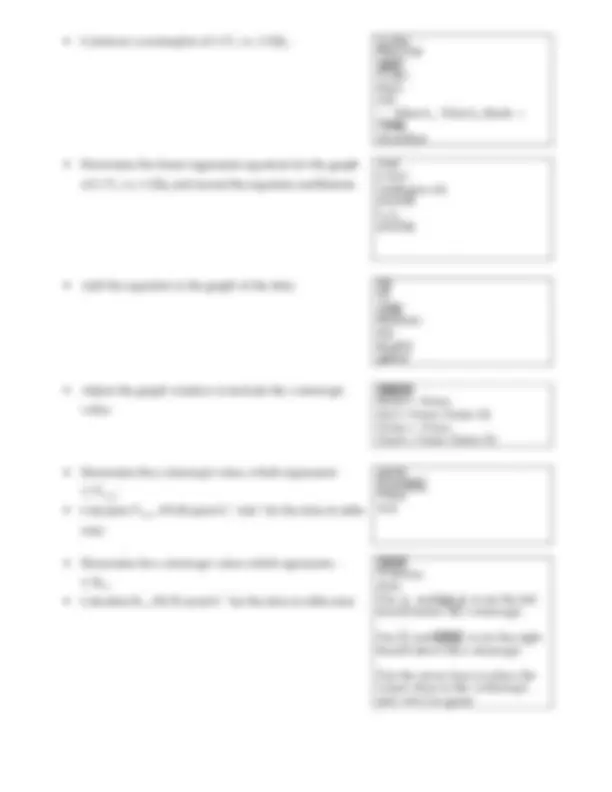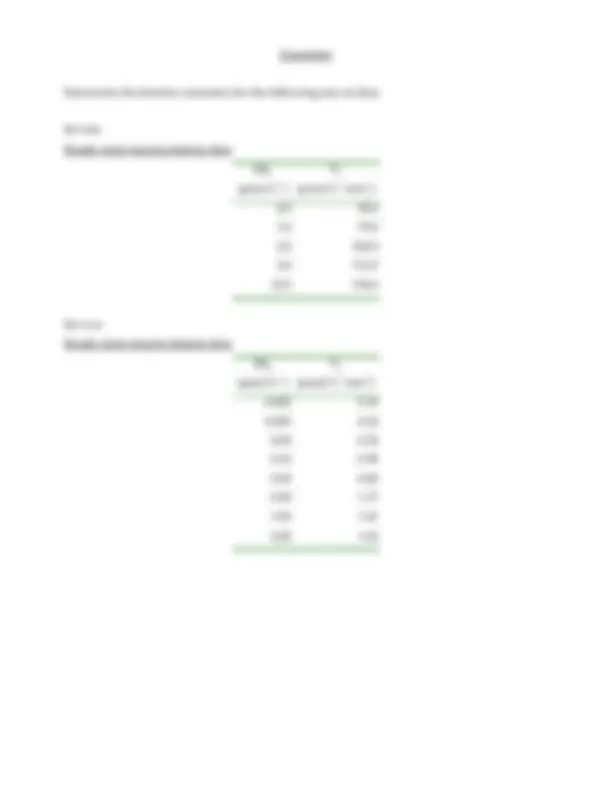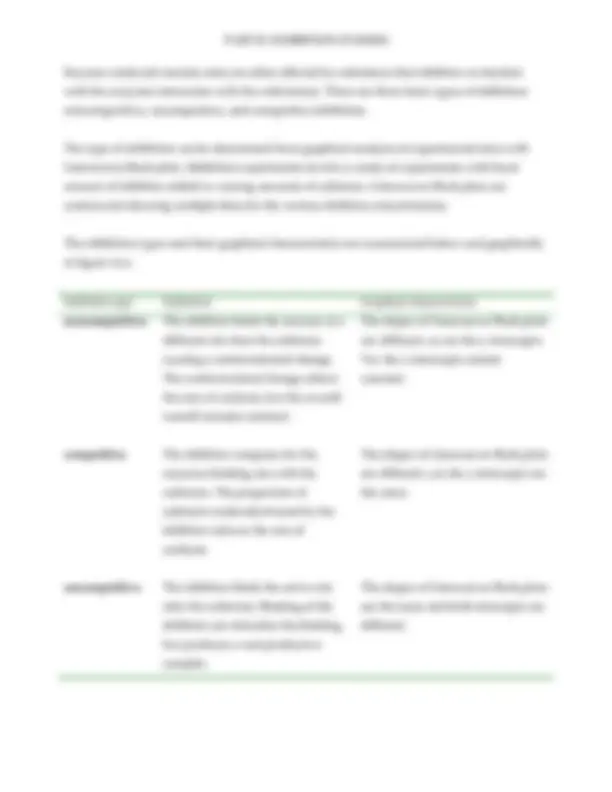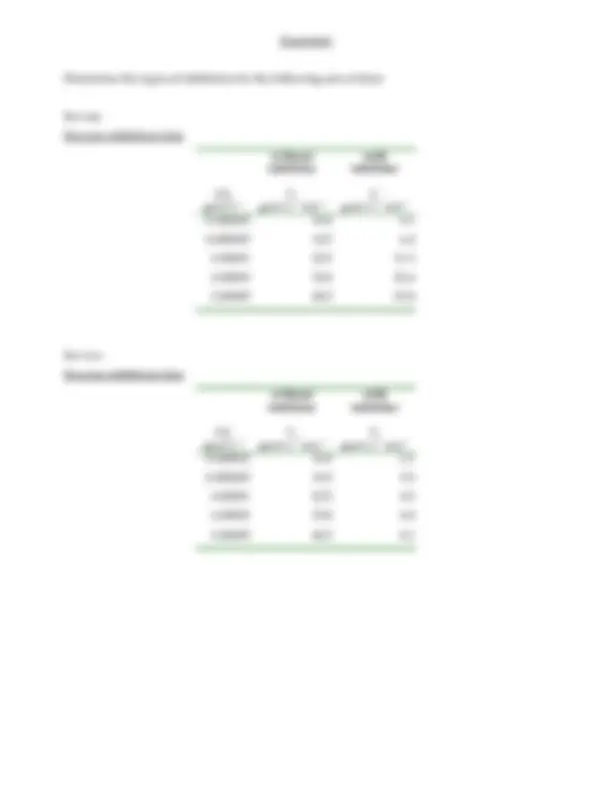






Study with the several resources on Docsity

Earn points by helping other students or get them with a premium plan


Prepare for your exams
Study with the several resources on Docsity

Earn points to download
Earn points by helping other students or get them with a premium plan
Community
Ask the community for help and clear up your study doubts
Discover the best universities in your country according to Docsity users
Free resources
Download our free guides on studying techniques, anxiety management strategies, and thesis advice from Docsity tutors
The procedure to analyze enzyme kinetic data using Lineweaver-Burk plots. It explains how to determine the kinetics constants Vmax and Km from the plot, and how to identify different types of inhibition: noncompetitive, uncompetitive, and competitive. a step-by-step guide on how to use a graphing calculator to perform the analysis.
Typology: Study Guides, Projects, Research
1 / 8

This page cannot be seen from the preview
Don't miss anything!





Analyzing Enzyme Kinetic Data with a Graphing Calculator
PART A: LINEWEAVER-BURK PLOTS
In discussing the properties of an enzyme, certain values, or parameters are determined experimentally under steady state conditions. These values are determined through kinetics studies and include:
Vmax : The so-called maximal rate of the catalyzed reaction. The enzyme's active site is saturated. Km : The Michaelis constant. The substrate concentration at which the reaction rate is one-half its maximum value. Also known as the turnover number.
These values are determined experimentally by recording the progress of an enzyme-catalyzed reaction using fixed amounts of enzyme and a series of different substrate concentrations.
A typical data set looks table one where Vo is the initial reaction velocity and [S]o is the substrate concentration.
Table one Steady-state enzyme kinetic data
[S]o (μmol L-1)
Vo (μmol L-1^ min-1) 0.1 0. 2.0 5. 10.0 20. 20.0 40. 40.0 64. 60.0 80. 100.0 100. 200.0 120. 1000.0 150. 2000.0 155.
Vmax and Km can be determined from linear regression analysis of a plot of 1/Vo vs. 1/[S]o, a so- called Lineweaver-Burk plot.
Figure one A Lineweaver-Burk plot of enzyme kinetic data.
In a Lineweaver-Burk plot the inverse of the x and y-intercepts represent the kinetics constants Km and Vmax respectively.
Use the procedure below and a graphing calculator to determine the kinetics constants for the data in table one.
Procedure
Clear all equations EDIT L 1 = So L 2 = Vo
Questions
Determine the kinetics constants for the following sets of data.
Set one Steady-state enzyme kinetic data [S]o (μmol L-1)
Vo (μmol L-1^ min-1) 0.5 50. 1.0 75. 2.0 100. 3.0 112. 10.0 136.
Set two Steady-state enzyme kinetic data [S]o (μmol L-1)
Vo (μmol L-1^ min-1) 0.020 0. 0.025 0. 0.04 0. 0.10 0. 0.20 0. 0.50 1. 1.00 1. 2.00 1.
Enzyme catalyzed reaction rates are often affected by substances that inhibitor or interfere with the enzymes interaction with the substrate(s). There are three basic types of inhibition: noncompetitive, uncompetitive, and competitive inhibition.
The type of inhibition can be determined from graphical analysis of experimental data with Lineweaver-Burk plots. Inhibition experiments involve a series of experiments with fixed amount of inhibitor added to varying amounts of substrate. Lineweaver-Burk plots are constructed showing multiple lines for the various inhibitor concentrations.
The inhibition types and their graphical characteristics are summarized below and graphically in figure two.
Inhibition type Definition Graphical characteristics noncompetitive The inhibitor binds the enzyme at a different site than the substrate causing a conformational change. The conformational change affects the rate of catalysis, but the overall turnoff remains constant.
The slopes of Lineweaver-Burk plots are different, as are the y-intercepts. Yet, the x-intercepts remain constant.
competitive The inhibitor competes for the enzymes binding site with the substrate. The proportion of substrate molecules bound by the inhibitor reduces the rate of catalysis.
The slopes of Lineweaver-Burk plots are different, yet the y-intercepts are the same.
uncompetitive The inhibitor binds the active site after the substrate. Binding of the inhibitor can stimulate the binding, but produces a non-productive complex.
The slopes of Lineweaver-Burk plots are the same and both intercepts are different.
Procedure
Clear all equations EDIT L 1 = So L 2 = Vo without inhibitor L 3 = Vo with inhibitor
Plot ON Xlist=L 4 Ylist=L 5 Mark: + Plot ON Xlist=L 4 Ylist=L 6 Mark:. ZoomStat
LinReg(ax+b) ENTER L 4 ,L 5 ENTER CALC LinReg(ax+b) ENTER L 4 ,L 6 ENTER
Questions
Determine the types of inhibition for the following sets of data:
Set one Enzyme inhibition data
[S]o mol L-
without inhibitor Vo mol L-1^ min-
with inhibitor Vo mol L-1^ min- 0.000003 10.4 4. 0.000005 14.5 6. 0.00001 22.5 11. 0.00003 33.8 22. 0.00009 40.5 33.
Set two Enzyme inhibition data
[S]o mol L-
without inhibitor Vo mol L-1^ min-
with inhibitor Vo mol L-1^ min- 0.000003 10.4 2. 0.000005 14.5 2. 0.00001 22.5 4. 0.00003 33.8 6. 0.00009 40.5 8.